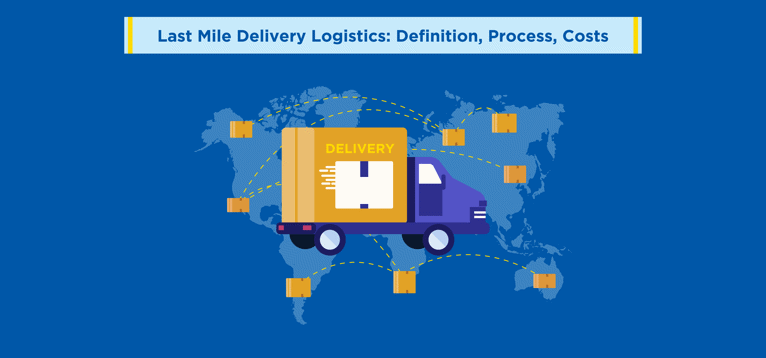Last mile delivery has a tremendous impact on sales and customer experience. Lapses in last mile delivery services account for three of the top ten reasons for cart abandonment.
As customers demand faster shipping, brands have to invest in last mile delivery logistics to meet their expectations.
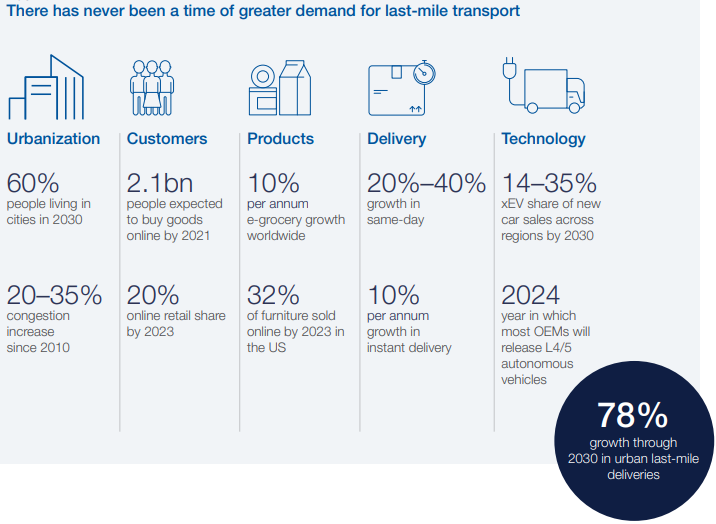
What is Last Mile Delivery?
Last mile delivery is the process of picking products from storage and delivering them to the point of consumption. The point of consumption can be a retail outlet or a customer’s address. It is the final journey of the product before the customer receives it.
Last mile delivery falls under delivery management. It is the final stage of order fulfilment and supply chain management. This is the last time a company has to move the products. Hence, this process is called the last mile of delivery.
The last mile delivery process depends on the type of business. Retail and eCommerce businesses need different types of last mile delivery services. The primary difference between last-mile delivery for these two businesses is the point of consumption.
Retail Last Mile Delivery
The store or outlet is the point of consumption for retail last mile delivery. In this model, the point of origin can be a manufacturing unit or a warehouse. Retail last mile delivery usually needs a large road freight vehicle.
You would bundle the products into cargo or crates for retail last mile delivery. Then you will transport this cargo in a truck or a van to the retail outlet. At the destination, you would remove individual products from the bundle to stock the retail store. The customer picks the products from the store for consumption.
Ecommerce Last Mile Delivery
The point of consumption in eCommerce last mile delivery is the customer’s address. In this model, the point of origin can be a warehouse or fulfilment centre. Ecommerce last mile delivery is usually done in smaller vehicles such as vans, motorcycles, and bicycles.
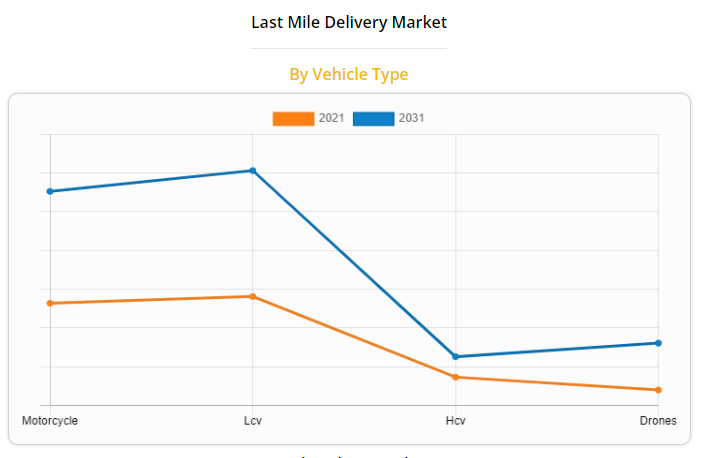
For eCommerce last mile delivery, you will need to pack each product individually. Then you will allocate deliveries to different vehicles. The vehicles will pick up the products from the storage unit. Then they will embark on individual routes to complete multiple deliveries. In eCommerce last mile delivery, each vehicle usually serves a cluster of locations.
Although, if you are offering self-fulfilment. Then you will follow the same model as retail last mile delivery. The only difference is that your destination will be a self-fulfilment centre instead of a retail outlet.
What is Ecommerce Last-Mile Delivery Process Flow?
The fundamental process flow for last mile delivery is fairly simple. Delivery personnel pick up the order from a warehouse. Then they deliver it to the customer’s address. Finally, they collect proof of delivery to complete the process.
But, owing to distances, the eCommerce last mile delivery process flow has become complex. The order changes hands several times before it reaches the customer.
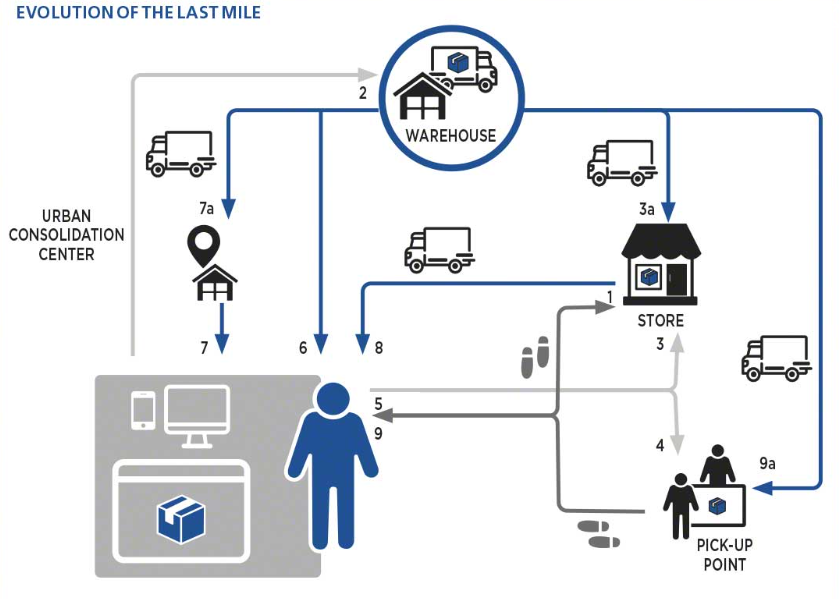
Companies have to employ a lot of resources to get the product to the customer’s address. Let’s understand the step-by-step process for eCommerce last mile delivery:
Step 1: The customer places the order and the order fulfilment process starts.
Step 2: The warehouse team packages the order for delivery.
Step 3: The delivery team receives relevant order details before dispatch.
Step 4: The delivery team picks up the order from the warehouse or micro-fulfilment centre.
Step 5: The delivery vehicle transports the order to the customer’s address.
Step 6: A delivery personnel delivers the order to the customer’s doorstep.
Step 7: The delivery personnel collects proof of delivery from the customer.
To complete this process, a company has to employ several resources. The resources and expenses depend on the delivery format. Some of the most common types of last-mile delivery formats include:
Owned Vehicle Fleet: The company uses its own fleet of vehicles to complete last mile deliveries.
Gig Economy: The company hires independent contractors to complete each last mile delivery.
3PL Services: The company hires a 3PL partner to handle all last mile deliveries.
Each of these formats has its benefits and drawbacks. Having a fleet gives you control over the process. But, it requires heavy investment in logistical resources. The latter two formats give you less control, but more flexibility.
What are the Costs of Last Mile Delivery?
Last mile delivery accounts for about 53% of the shipping expenses. The biggest areas of last mile delivery costs include:
- Fees/Salary of delivery personnel
- Cost of purchasing/hiring transport vehicles
- Maintenance cost of transport vehicles
- Fuel expenses for deliveries
- Cost of Equipment
- Cost of Delivery Management Software
- Cost of Insurance
To calculate the cost per last mile delivery, you need to divide these expenses by the total number of deliveries that you expect to complete. Remember to divide the long-term investments, like transport vehicles, into smaller units based on life expectancy. If you are using 3PL services, you can directly estimate the cost per delivery.
The Last Mile Delivery Problem & Challenges
According to the State of Shipping Report, there is a significant gap between customers’ expectations and actual delivery lead time. Here lies the last mile delivery problem.
Customers expect faster delivery and free shipping. Companies need to raise prices to meet these demands without reducing their margins. But, both high prices and slow deliveries can turn away customers.
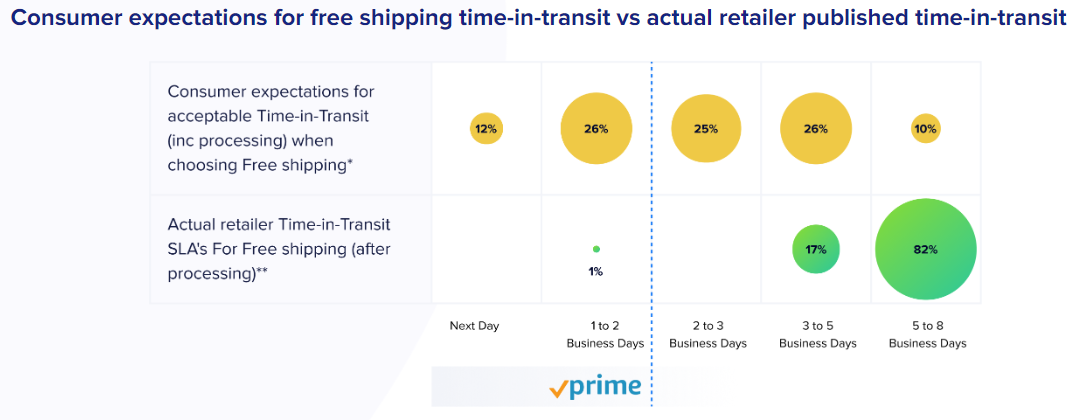
It is difficult for companies to meet these expectations owing to several last mile delivery challenges. Most of these stem from the resource, infrastructure, and investment requirements. Some of the biggest last-mile delivery challenges include:
- High cost of last-mile delivery
- Lack of on-ground visibility
- Slow transport options
- Lack of trained labour
- Inefficient route planning
- Scheduling deliveries for customer’s convenience
- Optimising warehouse, packaging, and loading
- Collecting proof of delivery
These challenges show that eCommerce brands have to invest in more resources to enable faster deliveries. They raise the prices to compensate for this investment. But in doing so, they risk losing customers. That is why companies need to optimise the last-mile delivery process flow.
How to Improve Last Mile Delivery?
Alongside the challenges, there are also quite a few opportunities to improve last mile delivery. Even minor improvements in the delivery process can pay incremental dividends in the long run. Optimising the last mile delivery process flow can help you complete more deliveries in a particular time frame. It can also help you cut down the cost per delivery.
Here are a few ways to improve your last mile delivery process flow:
- Use a delivery management platform to improve efficiency. The software also helps you gain visibility over the process.
- Create a streamlined order fulfilment process. Last mile deliveries depend upon the efficiency of the stages before it. These include warehouse management and packaging.
- Expand the network of fulfilment centres. You can develop micro-fulfilment centres near high-demand areas to enable faster last mile delivery.
- Use data analytics to drive decisions. Collect and analyse data to identify problem areas and opportunities for improvement.
- Find a reliable logistics partner for last mile deliveries. With 3PL services, you don’t have to invest in any resources to complete last mile deliveries.
- Use automation to improve efficiency. You can connect delivery management with your POS, inventory management, and CRM to speed up the delivery process.
- Offer alternative shipping options. You provide self-fulfilment or pick-from-store options to your customers. Then you only have to manage last mile delivery to a central location.
When improving last mile delivery, focus more on reducing the cost per delivery. Aside from the ones mentioned above, you can also use targeted marketing to achieve this.
You can focus your marketing efforts in a particular region to increase the number of orders. This will help you get more use from your resources in the region. You can also use cross-selling and upselling to raise the order value. This will help you offset the cost of last mile delivery against the profits.
Conclusion
Last mile delivery is a simple process, but a complex phenomenon. It is the last point of contact between a brand and its customers. Success at this stage is vital for customer satisfaction. But companies need a streamlined last mile delivery process flow to ensure that products can reach the customers within the committed time.
You can invest heavily in resources to create your own last mile delivery process. Or you can use a 3PL partner, like PACK & SEND, to carry out this process for you.
Image sources: World Economic Forum, Allied Market Research, Interlake Mecalux, X Delivery
